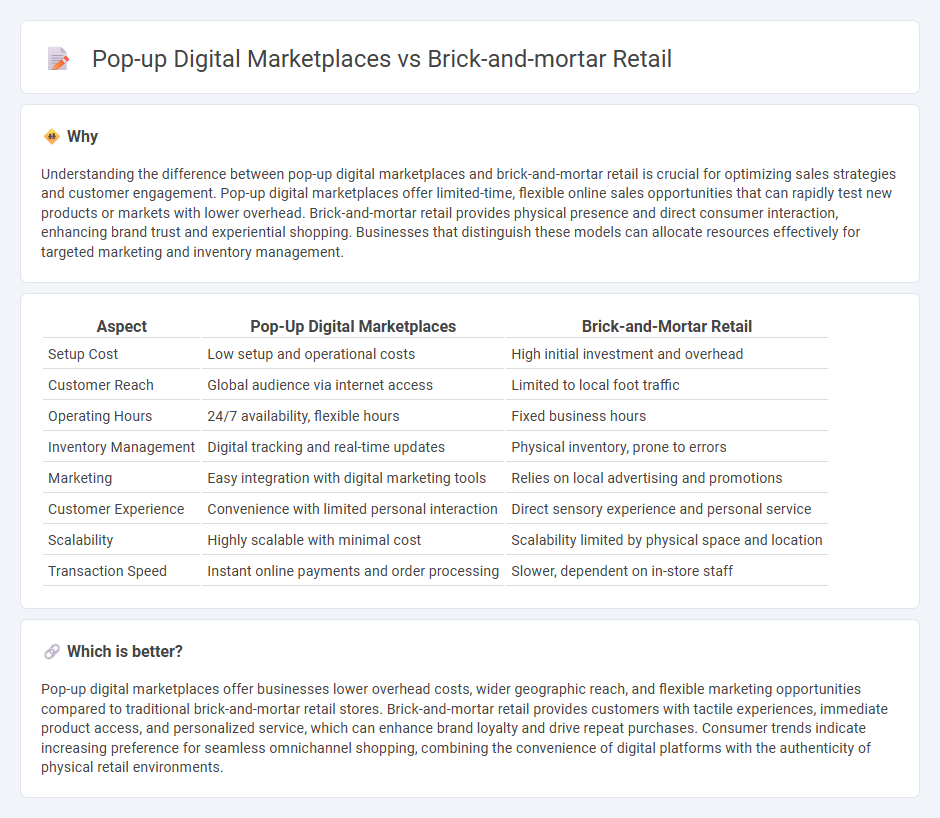
Pop-up digital marketplaces offer flexible, low-overhead platforms that rapidly connect sellers with diverse, global audiences, contrasting with brick-and-mortar retail's fixed locations and substantial operational costs. Digital pop-ups leverage targeted data analytics and personalized user experiences to drive immediate engagement and sales, while physical stores rely on tangible product interaction and local customer relationships. Explore the evolving dynamics between these commerce models to enhance your business strategy.
Why it is important
Understanding the difference between pop-up digital marketplaces and brick-and-mortar retail is crucial for optimizing sales strategies and customer engagement. Pop-up digital marketplaces offer limited-time, flexible online sales opportunities that can rapidly test new products or markets with lower overhead. Brick-and-mortar retail provides physical presence and direct consumer interaction, enhancing brand trust and experiential shopping. Businesses that distinguish these models can allocate resources effectively for targeted marketing and inventory management.
Comparison Table
| Aspect | Pop-Up Digital Marketplaces | Brick-and-Mortar Retail |
|---|---|---|
| Setup Cost | Low setup and operational costs | High initial investment and overhead |
| Customer Reach | Global audience via internet access | Limited to local foot traffic |
| Operating Hours | 24/7 availability, flexible hours | Fixed business hours |
| Inventory Management | Digital tracking and real-time updates | Physical inventory, prone to errors |
| Marketing | Easy integration with digital marketing tools | Relies on local advertising and promotions |
| Customer Experience | Convenience with limited personal interaction | Direct sensory experience and personal service |
| Scalability | Highly scalable with minimal cost | Scalability limited by physical space and location |
| Transaction Speed | Instant online payments and order processing | Slower, dependent on in-store staff |
Which is better?
Pop-up digital marketplaces offer businesses lower overhead costs, wider geographic reach, and flexible marketing opportunities compared to traditional brick-and-mortar retail stores. Brick-and-mortar retail provides customers with tactile experiences, immediate product access, and personalized service, which can enhance brand loyalty and drive repeat purchases. Consumer trends indicate increasing preference for seamless omnichannel shopping, combining the convenience of digital platforms with the authenticity of physical retail environments.
Connection
Pop-up digital marketplaces complement brick-and-mortar retail by creating temporary, immersive shopping experiences that drive brand awareness and consumer engagement. These digital platforms leverage augmented reality and location-based services to bridge the physical and virtual shopping worlds, enhancing customer convenience. Retailers capitalize on data gathered from pop-up marketplaces to optimize inventory and personalize in-store promotions, boosting overall sales performance.
Key Terms
Physical Storefront
Physical storefronts in brick-and-mortar retail offer tactile product experiences and immediate customer service, which enhance brand trust and loyalty. High foot traffic locations can boost spontaneous purchases, though they require significant overhead costs like rent and staffing. Explore how combining physical stores with digital pop-up marketplaces can optimize retail strategies and drive sales growth.
Temporary Online Platform
Temporary online platforms offer brick-and-mortar retailers a flexible and cost-effective way to reach digital audiences without long-term commitments. These pop-up digital marketplaces enable rapid market testing and personalized customer engagement through targeted data analytics. Explore how temporary online platforms can revolutionize your retail strategy today.
Customer Experience
Brick-and-mortar retail offers tactile product interaction and personalized in-store service, fostering trust and immediate gratification for customers. Pop-up digital marketplaces leverage data-driven personalization and seamless online transactions to enhance convenience and tailored shopping experiences. Explore how combining physical presence with digital innovation can elevate customer satisfaction and loyalty.
Source and External Links
What Is a Brick and Mortar Store? Top 10 Retail Examples - A brick-and-mortar store is a traditional retail business operating from a physical location where customers can visit to purchase products or services, offering hands-on experiences, immediate service, and local community engagement.
Brick and Mortar Stores: Types, Benefits, Examples (2024) - Brick-and-mortar retail refers to physical storefronts where customers browse, interact with products, and receive in-person assistance from sales staff, often serving as hubs for omnichannel experiences like in-store pickup and returns.
What Does It Mean to Be a Brick-and-Mortar Store? - The term "brick-and-mortar" distinguishes traditional businesses with physical locations from online-only retailers, emphasizing face-to-face customer interactions and the tangible aspects of shopping that digital channels cannot fully replicate.
 dowidth.com
dowidth.com